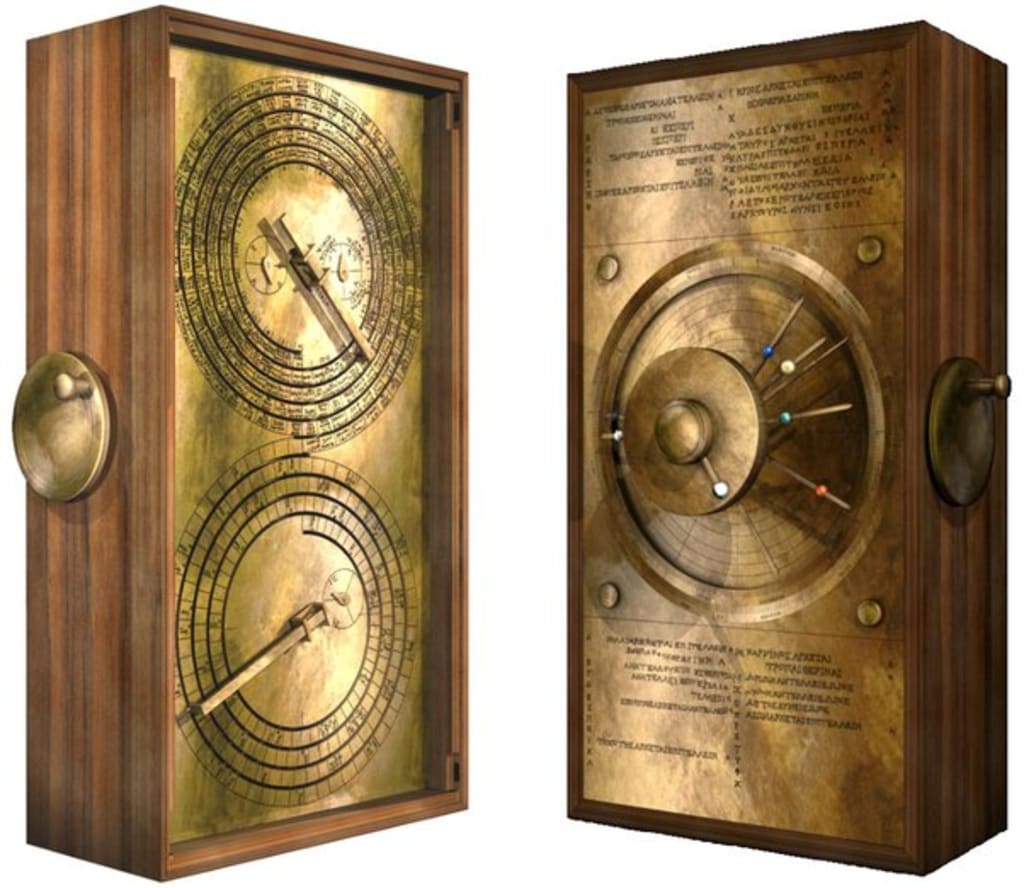The ENIGMA of The Antikythera Mechanism
Historical Mysteries

The Antikythera Mechanism, often referred to as the world's first analog computer, is a remarkable ancient Greek artifact that has fascinated historians, archaeologists, and scientists since its discovery in 1901. Found in the wreckage of a Roman cargo ship off the coast of the Greek island of Antikythera, this intricate device dates back to around 100 BCE. The Antikythera Mechanism's complexity and sophistication provide profound insights into the technological and astronomical knowledge of ancient civilizations, challenging our understanding of history and the development of science and engineering.
The story of the Antikythera Mechanism begins with its discovery by sponge divers off the coast of Antikythera in 1900. Among the shipwreck's treasures, including statues, pottery, and coins, was a corroded lump of bronze and wood that initially attracted little attention. However, when archaeologist Valerios Stais examined the lump a year later, he noticed that it contained gears and inscriptions. Subsequent investigations revealed that this was no ordinary artifact; it was a highly sophisticated mechanical device.
The Antikythera Mechanism consists of a complex assembly of at least 30 meshing bronze gears housed in a wooden case about the size of a shoebox. Its primary function was to predict astronomical positions and eclipses for calendrical and astrological purposes. The device could model the motions of the sun, moon, and the five known planets at that time (Mercury, Venus, Mars, Jupiter, and Saturn), demonstrating a level of technological and scientific understanding previously thought unattainable by ancient civilizations.
Detailed studies of the mechanism, particularly those utilizing modern imaging techniques such as X-ray computed tomography, have revealed the intricate details of its construction and operation. The front face of the device features a large dial with two concentric scales: one representing the 365-day Egyptian calendar and the other the 12 zodiac signs. A smaller subsidiary dial displayed the lunar cycle, including phases of the moon. By turning a hand-crank, the user could set the mechanism to a specific date and observe the corresponding positions of celestial bodies.
The back of the device is even more complex, featuring additional dials that tracked the Metonic cycle (a 19-year period after which the phases of the moon repeat on the same days of the year) and the Saros cycle (an 18-year period relevant to predicting eclipses). There is also evidence that the mechanism accounted for the variable speed of the moon's orbit, incorporating what is known today as the "epicyclic" model.
The precision and accuracy of the Antikythera Mechanism highlight the advanced understanding of astronomy and mechanics possessed by the ancient Greeks. The device's creators likely belonged to a tradition of Greek engineering and science that included figures like Archimedes and Hipparchus, who made significant contributions to mathematics, astronomy, and mechanics. The discovery of the Antikythera Mechanism challenges the conventional timeline of technological development, suggesting that such sophisticated technology existed much earlier than previously believed.
Despite the extensive research, many aspects of the Antikythera Mechanism remain shrouded in mystery. For instance, the exact purpose and use of the device are still debated. Some scholars believe it was used for educational purposes, to demonstrate astronomical theories, while others suggest it served as a navigational aid for sailors or an astrological tool for divination. Additionally, the identity of its creator and the extent to which such technology was widespread in the ancient world remain unknown.
The Antikythera Mechanism also raises intriguing questions about the transmission of scientific knowledge. Its sophistication suggests that the ancient Greeks had developed a level of technological expertise that was lost with the decline of their civilization and not rediscovered until the Renaissance. The mechanism's discovery underscores the importance of preserving and studying ancient artifacts, as they hold the potential to reshape our understanding of history.
Today, the Antikythera Mechanism is housed in the National Archaeological Museum of Athens, where it continues to be the subject of extensive study and fascination. Researchers from various disciplines, including archaeology, astronomy, and computer science, collaborate to unlock its secrets, utilizing cutting-edge technologies to reconstruct its functions and origins.
In conclusion, the Antikythera Mechanism stands as a testament to the ingenuity and scientific prowess of the ancient Greeks. Its discovery has profoundly impacted our understanding of ancient technology, revealing a level of complexity and sophistication that challenges our perceptions of historical progress. As research continues, the Antikythera Mechanism will undoubtedly yield further insights into the scientific achievements of the past, offering a remarkable glimpse into the technological prowess of ancient civilizations.
About the Creator
Marveline Merab
“History never repeats itself. Man always does.”
― Voltaire
Enjoyed the story? Support the Creator.
Subscribe for free to receive all their stories in your feed. You could also pledge your support or give them a one-off tip, letting them know you appreciate their work.






Comments
There are no comments for this story
Be the first to respond and start the conversation.